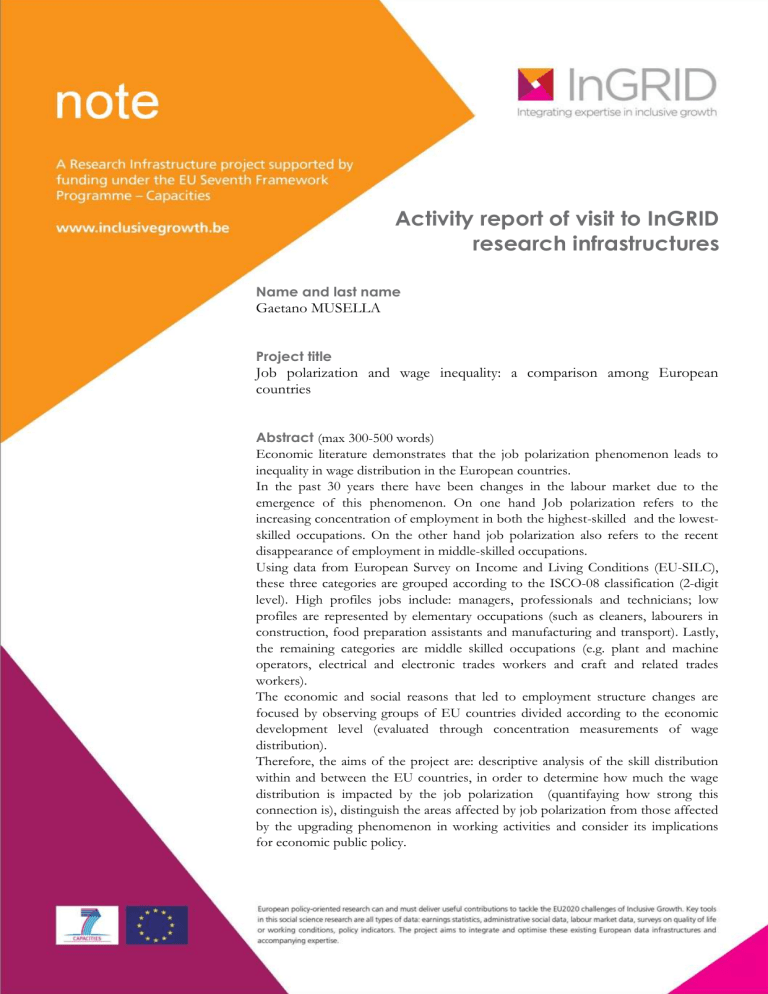Read report

Name and last name
Gaetano MUSELLA
Activity report of visit to InGRID research infrastructures
Project title
Job polarization and wage inequality: a comparison among European countries
Abstract (max 300-500 words)
Economic literature demonstrates that the job polarization phenomenon leads to inequality in wage distribution in the European countries.
In the past 30 years there have been changes in the labour market due to the emergence of this phenomenon. On one hand Job polarization refers to the increasing concentration of employment in both the highest-skilled and the lowestskilled occupations. On the other hand job polarization also refers to the recent disappearance of employment in middle-skilled occupations.
Using data from European Survey on Income and Living Conditions (EU-SILC), these three categories are grouped according to the ISCO-08 classification (2-digit level). High profiles jobs include: managers, professionals and technicians; low profiles are represented by elementary occupations (such as cleaners, labourers in construction, food preparation assistants and manufacturing and transport). Lastly, the remaining categories are middle skilled occupations (e.g. plant and machine operators, electrical and electronic trades workers and craft and related trades workers).
The economic and social reasons that led to employment structure changes are focused by observing groups of EU countries divided according to the economic development level (evaluated through concentration measurements of wage distribution).
Therefore, the aims of the project are: descriptive analysis of the skill distribution within and between the EU countries, in order to determine how much the wage distribution is impacted by the job polarization (quantifaying how strong this connection is), distinguish the areas affected by job polarization from those affected by the upgrading phenomenon in working activities and consider its implications for economic public policy.
Introduction and motivation of visit
At Tarki the Social Research Institute I was able to confront with experienced researchers on central issues to my research project: The Labour Market and Income Distribution. Another important goal of the visit was to increase my knowledge in social sciences, something that allowed me to better understand the impact of cultural and political context on income distribution and social exclusion.
Scientific objectives of visit
The visit had a dual objective: Increase the expertise on the empirical literature concerning the labour market and wage inequality and investigate the differences among European countries. The first objective has been achieved thanks to twenty years of experience of the Institute and the many publications concerning the topics. As for the international comparison information content of the dataset available from the Tarki, both concerning Hungary alone, both international due to the contribution of the institute to many international studies (The Tarki is a member of several international research networks as, for example, the Luxembourg Income Study, or the European
Social Survey) have been very helpful.
Reasons for choosing research infrastructure and datasets/surveys/...
The choice of the research facility was dictated by compatibility with my research interests.
Since I am interested in studying the labour market and income distribution, it was obvious to choose a center, like the Tarki, which focuses its activities on these two sectors. Moreover, thanks to its participation in various international research netwok, the possibility to access different types of data was determining in the choice.
Activities during your visit (research, training, events, ...)
During the visit I used the free access to the library and publications to enrich my literature search.
I took the opportunity to be able to have a confrontation with researchers and experts, also participating in a weekly meeting that proved to be a very informative event. The data processing activity complete the activities carried out during the period.
Method and set-up of research
In order to study the connection between the polarization of labour and income distribution, data
EU-SILC have been used. The choice of this dataset is explained by the need to make international comparisons among countries. The EU-SILC project's main objective is the systematic production of Community statistics on income, poverty and social exclusion, both transverse and longitudinal directions, pointing to the harmonization of a set of statistical indicators. This constitutes a major source of data for the periodic reports of the European Union on the social situation and the spread of poverty in the member countries.
Project achievements during visit (and possible difficulties encountered)
Through measures of inequality are created homogeneous groups of countries. The goal is to make a comparison, both between countries and between groups, in order to study the structure of the labour market. Through the empirical results, three cases emerge: countries with polarization of
2
work, countries that show the presence of upgrading and, lastly, countries where there is none of the above two phenomena. A final step is to look for the connection between the polarization and the income distribution.
References
Goos M., Manning A., Salomons A. (2014), Explaining Job Polarization: Routine-Biased Technological Change and Offshoring – The American Economic Review, vol.104, num.8, pp. 2509-2526.
Goos M., Manning A., Salomons A. (2009), Job Polarization in Europe - The American Economic Review, vol.99, num.2, pp. 58-63.
Autor D. H., Katz L. F., Kearney M. S. (2006), The Polarization of the U.S. Labour Market - American Economic
Review, Papers and Proceedings, vol.96, num.2, pp.189–194.
Autor D.H., Levy F., Murmane R. J. (2003), The Skill Content of Recent Technological Change: an Empirical
Exploration - Quarterly Journal of Economics, vol.118, num.4, pp.1279–1333.
Autor D.H., Katz L.F. (1999), Changes in the Wage Structure and Earnings Inequality - Handbook of Labor
Economics, vol. 3A., pp. 1463-1555.
3









